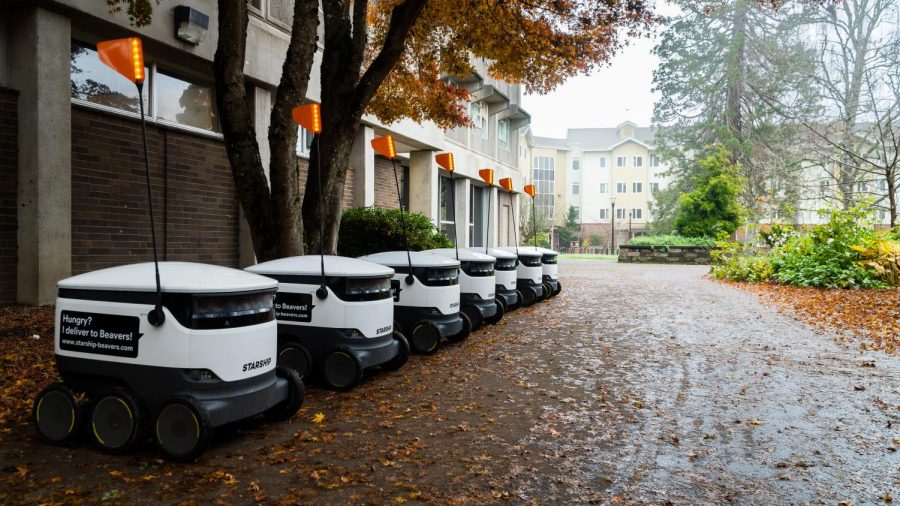OSU students offer opinions on six-wheeled rovers delivering food through winter weather
Starship robots await loading of food outside of the Arnold Dining Hall on Nov. 24, 2021. These robots deliver food to students from most dining locations on Oregon State University’s Corvallis, Ore. campus and are not expected to be impeded by the winter weather.
January 3, 2022
Oregon State University’s Starship robots face many challenges on campus, but students can expect the robots to continue delivering food even through Oregon’s winter season.
“They slip and slide around a bit in the snow and ice,” said Kerry Paterson, director of University of Housing and Dining Services at OSU. “Rain isn’t an issue. They are pretty rugged little machines and do okay.”
Since a deal was made with the autonomous robotics company prior to the COVID-19 outbreak, OSU students have been able to have food delivered to their residences with use of the Starship app.
Initially, Starship reached out to OSU because they thought the university would be a good fit for their robot delivery service, according to Paterson.
“Our campus is somewhat easy for a robot to navigate, we offered great food selections across campus and OSU had a robot program, so we were already familiar with the idea of robots on campus,” Paterson said.
According to Paterson, during the COVID-19 shut down, the robots provided contactless service and online orders, which helped limit the time guests spent in dining centers. This pick-up option is still available.
“The robots also give the students [and] users the ‘gift of time,’ they no longer need to stop what they are doing, pack up, go to a dining hall or café, order food, wait, eat and go back to what they were doing,” Paterson said.
OSU students are not strangers to the invention of machinery, as the presence of robotics is felt through innovations like Cassie, the bipedal robot that became the first to travel five kilometers on campus with the goal of going anywhere a person can go.
Aside from the bipeds, the six-wheeled Starship rovers are moving throughout winter term to deliver food to students.
“I’ve only ever seen them around campus and never used them,” said Eric Elizarraga, a junior at OSU. “They seem to be pretty popular and I always seem to run into them going to class, the gym and just around campus. They’re everywhere, which is cool!”
Their popularity grows as the fleets of robots seem to increase in size. Though exciting for many, there are some downsides, according to Elizarraga.
“In my opinion they seem to be really slow and seem to get stuck in traffic a lot,” Elizarraga said. “They should continue to improve the speed of the Starship before thinking of having them do other things… I don’t know what else they could do, but I’d love to see what they have in mind.”
Other obstacles that the robots face include crossing busy roads and people’s accommodation of their presence.
“Oregon’s friendly drivers [will stop] at a crosswalk so [the robots] can cross, when in reality the robot will not move when its sensors identify a vehicle present,” Paterson said.
According to Paterson, Starship continues to improve their robot delivery service.
Robots and humans interacting with each other is likely to become commonplace as time goes on, and if robots are to continue to deliver food to the OSU community, students and other community members may need to deliver help in return when the robots face challenges.
“If one does get stuck, students are usually willing to assist and get it on its way before Starship staff have even reached the robot,” Paterson said.











































































































